Ghost gear: Educational guide and activity book
© Her Majesty the Queen in Right of Canada, 2022.
Cat. No. Fs23-674/2022E-PDF
ISBN 978-0-660-44544-1
On this page
- Introduction
- Section 1: What is ghost gear?
- Section 2: Effects of ghost gear
- Section 3: What can we do about ghost gear?
- Learn more

Introduction
Ghost gear is a harmful form of marine debris that affects our oceans, and many lakes and rivers around the world. This global danger was identified decades ago, but is only now being extensively researched and actively addressed.
This guide provides information on ghost gear, including what it is, where it comes from, what the effects are, and what is being done to address it in Canada and around the world.
This guide is organized into three sections:
- What is ghost gear?
- The effects of ghost gear
- What can we do about ghost gear?
Each section includes free, printable, engaging activities for youth G4-12 for fun at home or for use in a classroom setting.
The written materials and concepts are suitable for G8-12, and can be easily adapted by parents or teachers to educate younger students about ghost gear.
This educational guide and activity book was made possible by the Government of Canada’s Ghost Gear Fund.

Section 1: What is ghost gear?
Ghost gear is abandoned, lost or discarded fishing gear in the marine environment.
Ghost gear can be:
- fishing nets
- rope
- traps
- pots
- floats
- fishing line
Once lost, this gear can continue to catch fish and other marine animals, which is called ‘ghost fishing.’ Ghost gear exists in all areas of the ocean and in rivers and lakes around the world.
Ghost gear is the most harmful type of marine debris, damaging vital ocean habitats, marine wildlife, human health and safety, and the economy.
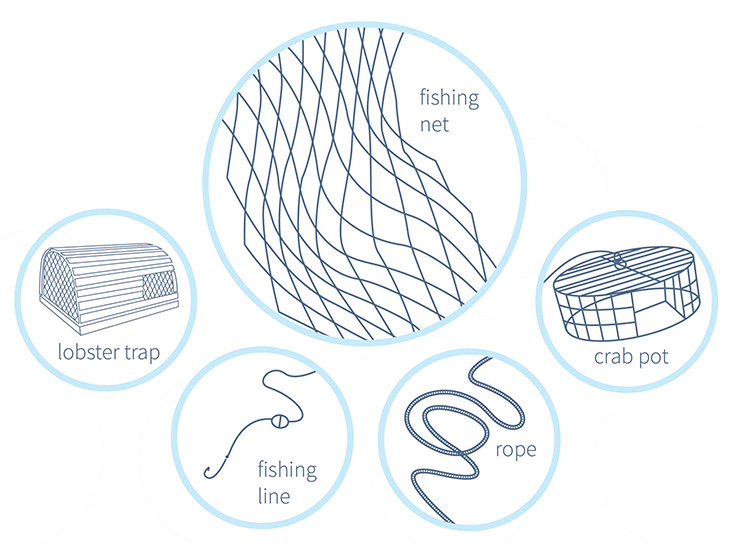
Ghost gear is found all over the world – even in the deepest lakes and in the most remoted areas of the ocean.
Where does ghost gear come from?
Abandoned, lost, or discarded fishing gear (ALDFG), or ghost gear, can end up in the water for a variety of reasons.
Fishing gear can get caught on reefs, rocks, or other underwater obstacles. It can also get tangled up with other fishing gear. When this happens, it may be impossible for the fisher to haul it back out of the water.
Fishing gear can also be lost at sea during stormy weather or pulled under the water by strong currents. In some situations, a fisher may have to cut the fishing gear loose to prevent the boat from being pulled under the water.
It is also very common for a boat to accidentally run over fishing gear and unintentionally break it free.
Intentional discard of fishing gear at sea is uncommon. Fishing gear is expensive, and the loss of gear can be devastating to a fisher. Often, intentional discard is associated with illegal, unregulated, and unreported (IUU) fishing, where gear is often dumped in the water to hide illegal activities.
However, in areas of the world that don’t have disposal or recycling options, as a last resort, fishing gear can end up in the water at the end of its life, or piled in coastal areas where it can be harmful to animals.

Why is ghost gear such a big problem?
Ghost gear is the most dangerous type of marine debris. It damages ecosystems, harms wildlife, and threatens the safety and livelihoods of people all over the world. And every year, more ghost gear is lost, adding to an already significant problem.
Ghost gear can drift on the surface of the water, float through the water at varying depths, or sink to the ocean floor–or it can do all three. Ghost gear can be very difficult to find and remove. In many cases, it is too deep or too tangled to remove safely.
In the next sections of this guide, we’ll examine the effects of ghost gear on ecosystems, wildlife, and people, and we’ll look at what Canada and the rest of the world are doing to solve this huge problem.

It is estimated that ghost gear makes up as much as 70% of the weight of floating macroplastics in the five major ocean gyres (circular ocean currents).
Glossary of terms
- Abandoned, lost, or discarded fishing gear (ALDFG), or, ‘ghost gear’
- Abandoned, lost or discarded fishing gear in the marine environment.
- Biodegradable
- Being made of materials that can be degraded by natural processes and return to the natural environment without any ecological harm.
- Bioplastics
- Plastic materials produced from biomass sources like vegetable fats and oils, corn starch, straw, woodchips, sawdust, recycled food waste, etc.
- Buoy
- An anchored float serving as a marker for navigation, showing hazards, marking fishing gear, or for mooring.
- Economy
- The management of financial matters for a country, community, business or family. Simplified, it’s the way people make money and spend money.
- Ecosystem
- A geographic area where plants, animals, and other organisms, as well as weather and landscape, interact with one another.
- End-of-life gear
- A piece of equipment that has reached the end of its ‘useful life’ and would now need to be disposed of, recycled or repurposed.
- Entangle
- To become caught in or twisted together with.
- Extended producer responsibility (EPR)
- An approach to recycling that requires producers, such as manufacturers, distributors, and retailers to take responsibility for the life cycle of the products they sell, including collection and recycling.
- Ghost fishing
- A term that describes what happens when lost fishing gear ‘continues to fish.’
- Ghost gear
- Abandoned, lost, or discarded fishing gear in the marine environment.
- Global positioning system (GPS)
- A satellite-based radio-navigation system that identifies precise locations anywhere in the world.
- Gyre
- A gyre is a series of ocean currents that move in a circular pattern. There are five major ocean gyres, which have been accumulating large amounts of floating ocean plastics. The five major ocean gyres are located in the North Atlantic Ocean, South Atlantic Ocean, North Pacific Ocean, South Pacific Ocean, and the Indian Ocean.
- Habitat
- The natural home or environment of an animal, plant, or other organism.
- IUU Fishing
- Illegal, unreported and unregulated fishing, which is a major contributor to declining fish stocks and marine habitat destruction.
- Livelihood
- The way you make your living and pay for the basic things you need in life. An example of livelihood is your job or profession.
- Macroplastics
- Large plastic particles (more than 5 mm in length).
- Marine
- Of, found in, or produced by the sea.
- Microplastics
- Small plastic particles (less than 5 mm in length).
- Navigational hazard
- Any obstacle encountered by a vessel at sea, posing a risk or danger to the vessel, its contents or the environment.
- Side scan sonar
- A piece of equipment that sends and receives acoustic pulses that help map the seafloor or detect objects.
- Unmanned aerial vehicle (UAV)
- An aircraft without a pilot, which can fly remotely with a controller or tablet, or programmed to fly on its own. Commonly known as a ‘drone.’
- Water column
- The vertical space between the surface of a sea, river, or lake and the bottom sediment.
- Vessel
- A ship or boat.

Activity: Word search
Help the recovery team pull up a ghost net by circling these words:
- gear
- reef
- boat
- animal
- net
- rocks
- trap
- ocean
- water
- rope
- fish
- kelp

Answer: Word search
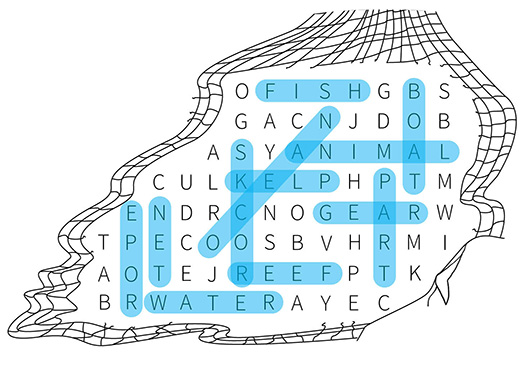
Colouring question: Ghost gear can affect many different species. Can you colour all of the living things that can be harmed by ghost gear?
Answer: Colouring question
In this scene, ghost gear can harm:
- fish
- starfish
- plants
- crab
- octopus
- sea lions
- seagulls
- people
Activity: Coded message
Use the alphabet key below to reveal this important coded question.
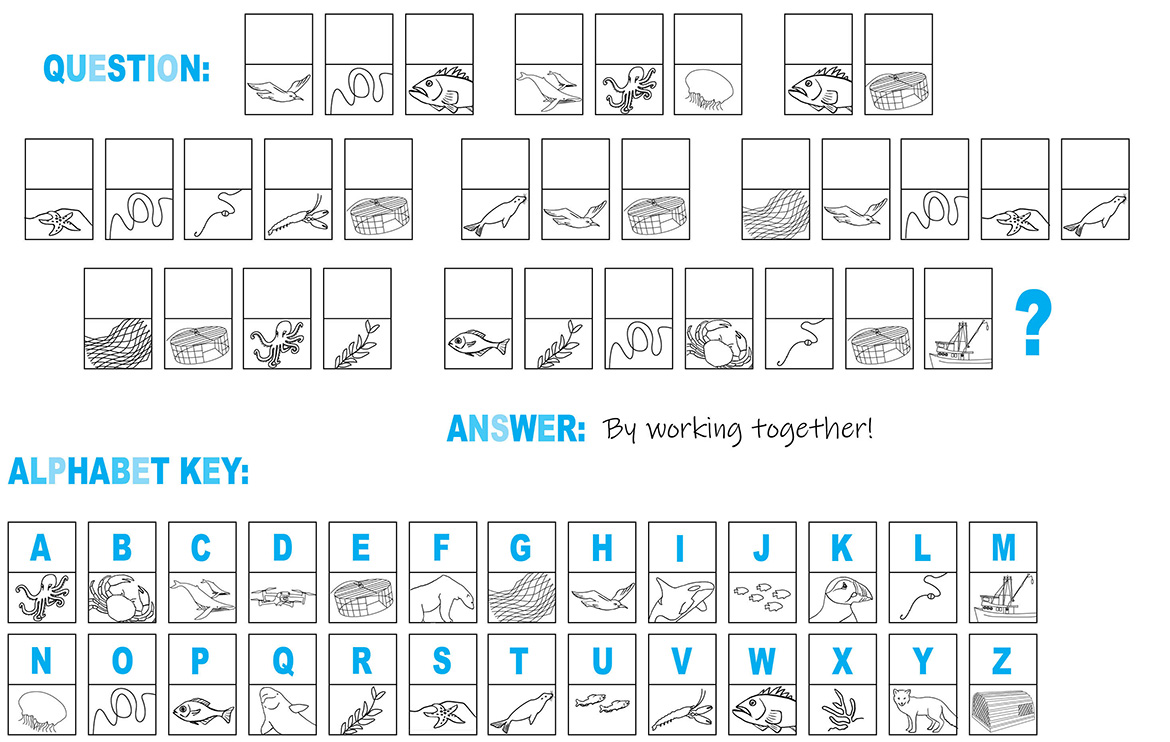
Text version
Alphabet key:
- A = Octopus
- B = Crab
- C = Whales
- D = Drone
- E = Crab pot
- F = Polar bear
- G = Fishing net
- H = Seagull
- I = Killer whale
- J = School of 5 fish
- K = Puffin
- L = Fishing line
- M = Fishing boat
- N = Jellyfish
- O = Rope
- P = Perch
- Q = Beluga whale
- R = Seaweed
- S = Starfish
- T = Seal
- U = School of 3 fish
- V = Lobster
- W = Rockfish
- X = Coral
- Y = Arctic fox
- Z = Lobster trap
Coded question
Word 1, 3 letters:
- Seagull
- Rope
- Rockfish
Word 2, 3 letters:
- Whales
- Octopus
- Jellyfish
Word 3, 2 letters:
- Rockfish
- Crab pot
Word 4, 5 letters:
- Star fish
- Rope
- Fishing line
- Lobster
- Crab pot
Word 5, 3 letters
- Seal
- Seagull
- Crab pot
Word 6, 5 letters:
- Fishing net
- Seagull
- Rope
- Star fish
- Seal
Word 7, 4 letters:
- Fishing net
- Crab pot
- Octopus
- Seaweed
Word 8, 7 letters:
- Perch
- Seaweed
- Rope
- Crab
- Fishing line
- Crab pot
- Fishing boat
Question: How can we solve the ghost gear problem?
Answer: Coded message
Answer: By working together!
Section 2: Effects of ghost gear
Ghost gear is harmful marine debris that can have devastating effects on ecosystems, wildlife, and people.
Ghost gear and its effects are not always easy to see. In some areas of the world, ghost gear is obvious: it can be seen through clear tropical waters or washing up on beaches. In other environments, like the rich cold waters of Canada, it can float invisibly in dark, murky water.
The dangers of ghost gear are still being studied, but it is clear that it’s damaging the environment faster than we can keep up with.
This section of the guide will look at the effects of ghost gear that we know about so far–on ecosystems, wildlife, and people.
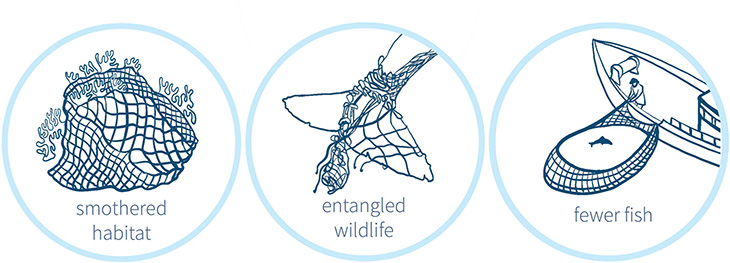

Effects on ecosystems
When ghost gear is lost, it can drift for hundreds of kilometres, becoming tangled with other gear or around natural formations like reefs and rock spires. It can also sink to the bottom and smother vital habitat.
In Canada, ghost gear has been found in sensitive wetlands and other fragile coastal habitats. It has been spotted in remote arctic regions, and it has been found drifting in our biggest and most important rivers. In other parts of the world, ghost gear has damaged fragile coral reefs and mangrove forest wetlands, which are important habitats for many living things.
Ghost gear also adds to the problem of plastic pollution in our oceans. Modern fishing gear is made with plastics like nylon and polypropylene, which are designed to last a very long time. Plastic can take decades to break down into smaller pieces, and hundreds of years to break down into microplastics. This means that ghost gear can cause damage to the environment over a long period of time, and then cause further damage as microplastics.


Effects on wildlife
Ghost gear can cause serious injury to both marine and land animals and is considered to be a leading cause of marine animal deaths every year.
When gear is lost, ‘ghost fishing’ can occur, which is when gear continues to catch fish, crabs, turtles, marine mammals, and many others. Predator and scavenger species can also become entangled when they approach their prey caught in the gear.
In many environments, ghost gear is almost impossible for wildlife to see and avoid. Ghost gear can move unpredictably and can drift in dark areas of the water where it is almost invisible. In areas above water where net is piled or where gear has washed ashore, small pieces of ghost gear can be ingested by seabirds or other animals, and even large animals like caribou can become entangled.
Although there are many inspiring stories of wildlife being freed from ghost gear by divers and fishers, unfortunately, most entangled wildlife pass away from suffocation, starvation, or exhaustion. This is a very sad reality, and one that many people are working hard to change.
Approximately 45% of marine mammals on the global threatened species list have been impacted by lost or abandoned fishing gear.


Effects on people
Ghost gear threatens human safety, health, and livelihoods.
Ghost gear can threaten people’s lives and cause marine accidents. Rope and net can easily get caught in a boat’s propellor or rudder, causing the vessel to lose control.
Ghost gear can also be a safety hazard in many coastal areas that depend on natural barriers like reefs and mangroves for protection against flooding and erosion. Ghost gear can damage these coastal habitats, putting entire communities at risk.
Ghost gear also reduces harvestable species that we depend on for food. This could mean that in certain parts of the world, fishers and their families could struggle to obtain enough to eat. One study estimated 90% of species caught in ghost gear were of commercial value. So, with fewer fish and other seafoods to catch, there could be an economic impact, with price increases and job losses.
Because ghost gear affects everyone negatively, many groups around the world are working together to reduce ghost gear, and its effects on ecosystems, wildlife, and people. The last section of this guide explores the creative solutions being done in Canada and the amazing collaborations happening around the world.
5-30% of fish stocks in some areas are caught in ghost gear every year.

Activity: Crab maze
These lost crab pots ended up piled here after a storm. Help the crab find his way through the traps and out the biodegradable escape hatch at the top of the pile.
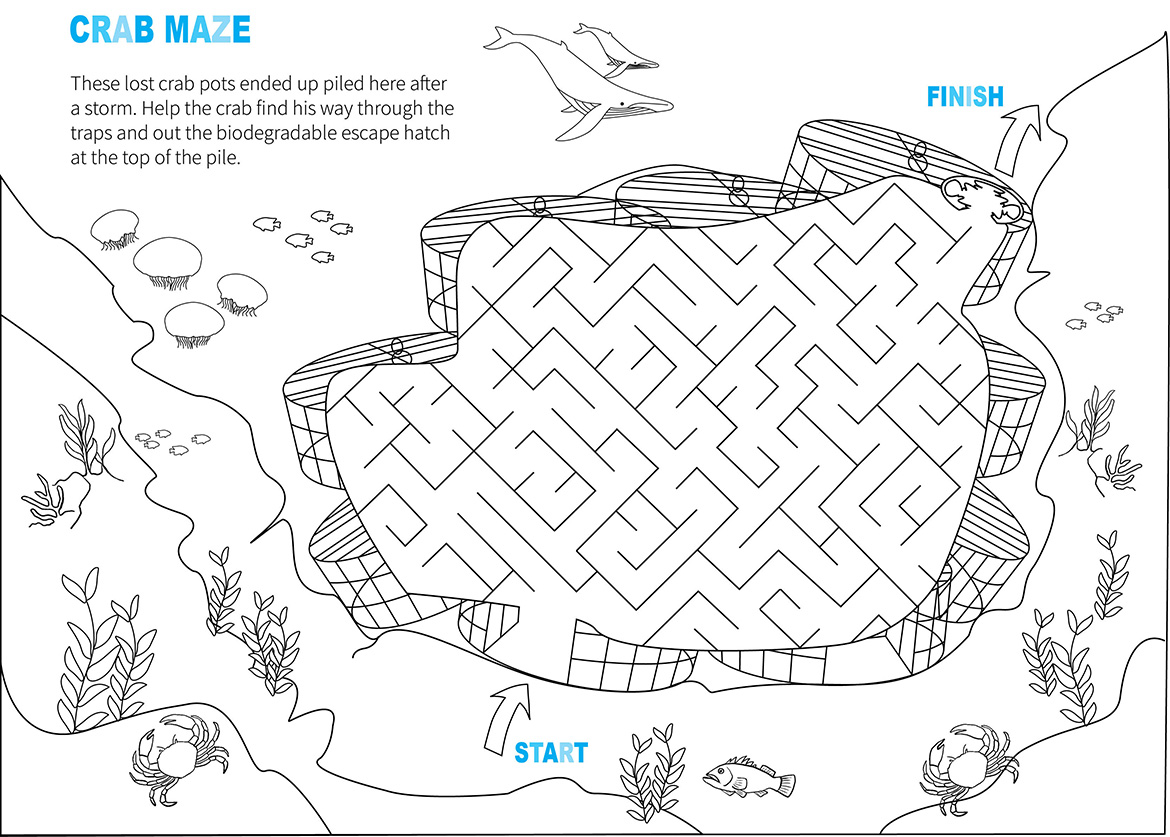
Answer: Crab maze

Activity: True or false
How much have you learned about ghost gear so far?
- True or False - Ghost gear is harmful to animals, people and the environment
- True or False - Ghost gear is found in lakes and rivers
- True or False - Ghost gear only ends up in the water because fishers have no where else to dispose of it
- True or False - Ghost gear is often lost in the water when another boat runs over it, cutting it free
- True or False - When ghost gear sinks to the ocean bottom, it is no longer a danger to animals
- True or False - Land animals can be affected by ghost gear
- True or False - Ghost gear can threaten the health and safety of people all over the world
- True or False - Many people are working together on creative solutions to solve the problem of ghost gear.
Answer: True or false
- True: Ghost gear is harmful to animals, people and the environment
- True: Ghost gear is found in lakes and rivers
- False: Ghost gear only ends up in the water because fishers have no where else to dispose of it
- True: Ghost gear is often lost in the water when another boat runs over it, cutting it free
- False: When ghost gear sinks to the ocean bottom, it is no longer a danger to animals
- True: Land animals can be affected by ghost gear
- True: Ghost gear can threaten the health and safety of people all over the world
- True: Many people are working together on creative solutions to solve the problem of ghost gear
Activity: Crossword
Can you solve the crossword puzzle below? Be sure to check the glossary for clues!

Text version
Across:
- 4) Ghost gear is harmful marine _ _ _ _ _ _ (6 letters)
- 5) Ghost gear can harm important and fragile _ _ _ _ _ _ _ _ (8 letters)
- 7) Many different people around the world are working together to find _ _ _ _ _ _ _ to the ghost gear problem (7 letters )
- 8) An effective way to find ghost gear is to use side scan _ _ _ _ _ (5 letters)
- 9) Ghost nets can smother fragile coral _ _ _ _ _ (5 letters)
- 10) Crab _ _ _ _ can be lost at sea during stormy weather (4 letters)
- 11) Fishing _ _ _ _ are often cut through by passing marine traffic (4 letters)
Down:
- 1) Ghost gear is found in _ _ _ _ _ _, lakes and rivers worldwide (6 letters)
- 2) Plastic particles that are less than 5mm in length are called: _ _ _ _ _ _ _ _ _ _ _ _ _ (13 letters)
- 3) When lost gear continues to fish, this is called: _ _ _ _ _ _ _ _ _ _ _ _ (2 words, 5 letters and 7 letters)
- 6) We can find solutions to the ghost gear problem by working _ _ _ _ _ _ _ _ (8 letters)
- 9) There are many teams trained to go out and _ _ _ _ _ _ _ ghost gear (7 letters)
Answer: Crossword
Across:
- 4) Debris
- 5) Habitats
- 7) Solutions
- 8) Sonar
- 9) Reefs
- 10) Pots
- 11) Nets
Down:
- 1) Oceans
- 2) Microplastics
- 3) Ghost fishing
- 6) Together
- 9) Recover
Section 3: What can we do about ghost gear?
When a complicated problem like ghost gear threatens the health of our oceans and other important waterways, it can leave us feeling distressed and overwhelmed.
It’s important to know that many scientists, governments, Indigenous communities, companies, environmental groups, fishers, and volunteers around the world are working hard on this issue every day–and they are making a big impact.
Solutions to the problem of ghost gear are approached in many different ways. Some groups are looking at how to prevent the loss of gear. Some groups are researching how much ghost gear is out there and where it ends up. Some groups are removing ghost gear from the water and restoring important habitats. And some groups are working on new technologies that can make fishing gear less harmful if it gets lost in the future.
Every year there is significant progress, but there is still a lot of work ahead. Solving this problem will require many people to join efforts, think creatively, and stay the course!
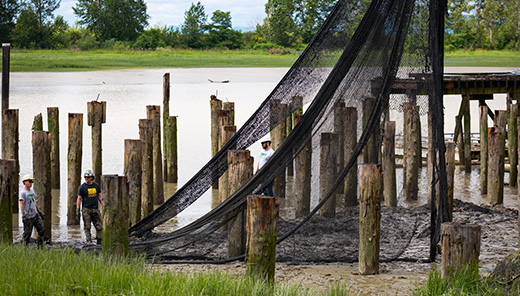
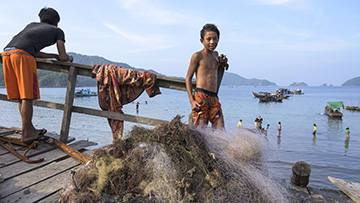

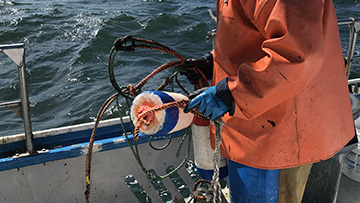
What is Canada doing?
Governments around the world are looking at effective ways to tackle the problem of ghost gear.
Canada is a world leader in this effort and, since 2018, has developed several innovative programs and initiatives that are making a big difference.
In 2020 the Canadian Government launched the Ghost Gear Fund. The fund addresses ghost gear in four areas: retrieval, responsible disposal, innovative technologies, and international leadership. Over two years, $16.7 million was given to organizations working on the removal of historic gear and preventing gear loss in the future.
Canada is also leading in data collection, which is critical to understanding the ghost gear problem. Canadian fishers label their gear and must report it if it gets lost. This mandatory reporting helps other groups find the gear, remove it and then give it back to its owner. Very few countries have created a system like this, and Canada’s is so advanced that the data being collected is helping us understand ghost gear in new ways.
From 2020-2022, Canada’s ghost gear program removed 1441 metric tonnes of ghost gear from Canada’s Atlantic and Pacific Coasts.

In 2020, Canada hosted the first ever Gear Innovation Summit in Halifax. This gathering of creative problem solvers involved people from the fishing industry, technology, government, and environmental groups. They met to discuss and showcase new technologies and new solutions for gear loss and recovery.
Canada is also working hard with groups around the world on ghost gear. Canada joined the Global Ghost Gear Initiative (GGGI) in 2018, which is the world’s only global platform that brings everyone together to solve the problem of ghost gear. Since joining the GGGI, Canada has become a global leader on this critical ocean issue.
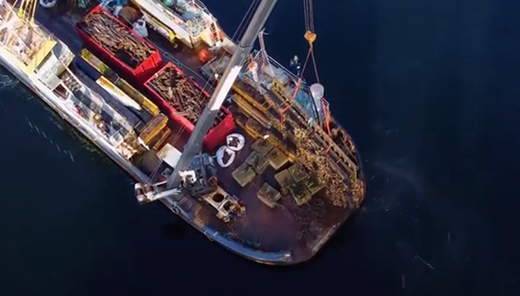


What other creative solutions are there?
Solutions to the ghost gear problem are out there. Many groups are working hard to:
- invent safer fishing gear
- raise awareness
- improve recycling methods
- create new policies and regulations
Around the world, new fishing gear technologies are being studied and tested. Researchers are looking for ways to create or change fishing gear so that if it gets lost in the future, it does not harm wildlife or the environment. For example, crab and lobster traps often have a rope running from the trap up to the surface of the water, where there is a floating buoy. Many animals swim through these ropes and become entangled in them. However, new inventions like ropeless traps would prevent this type of entanglement. When a rope is needed to collect the trap, a roped buoy springs up from the trap to the water’s surface.
There are also traps being created that have escape hatches, which biodegrade to allow animals to escape after a set number of days. And there is research being done to use bioplastics for gear like fishing nets that remain strong for fishers, but break down after a set period of time into natural materials.
New technology can also help us find ghost gear, which can be difficult and costly to find. Many groups are now using side scan sonar machines on boats to create maps of the ocean floor that show exactly where ghost gear is located. There is also work being done to test UAVs (drones) that use artificial intelligence to search for gear on their own and send the information back to ghost gear recovery teams. Even GPS tracking with smart buoys are being tested on fishing gear to notify fishers if their gear gets lost so they can retrieve it.

Communities around the world are also coming together and working creatively to clean up ghost gear and raise public awareness. In British Columbia, every year, fishers and Indigenous communities organize a huge clean-up of crab traps and other gear off the north coast. In Florida, USA, an annual Ghost Trap Rodeo is held, where fishers and recreational boaters go out and retrieve ghost gear to raise awareness and win prizes. In Australia, Indigenous communities create sculptures from recovered ghost gear that they display around the world in museums to raise awareness. In Nigeria, environmental groups build collection sites for end-of-life fishing gear, which is then reused by local youth and artists to create crafts and artwork.
In many countries, solutions are being created at the government level. For example, the European Union (EU) has made it mandatory that companies who make fishing gear also take them back once they’re ready to be disposed of. This is called Extended Producer Responsibility (EPR), and it will be the law for many European countries starting in 2025.
Since 2015, the Global Ghost Gear Initiative (GGGI) has brought together 18 national governments and over 120 members around the world from the fishing industry, scientists, technology companies, environmental groups and more to work together to solve this problem. The GGGI has supported work on ghost gear in many countries around the world, such as:
- Myanmar
- Vanuatu
- Indonesia
- Mexico
- the United States
- Jamaica
- Grenada
- Belize
- the United Kingdom
- Nigeria
- Greece

What can I do?
There have been amazing achievements that began with just one person wanting to make a difference. If you have read this guide and feel compelled to do something, here are some suggestions to get you started.
Be Informed! Ghost gear is a complicated problem, and it is often misunderstood. Be sure to read information from trusted sources and always fact-check.
Support initiatives that work on ghost gear or marine plastic pollution. Sign up for a newsletter, follow an organization that works on ghost gear on social media, keep your eye out for potential volunteer opportunities, or pledge to a campaign such as:
- Join the 10,000 Changes campaign
- Make a pledge to #BePlasticWise
- Reduce your plastic footprint and join #CleanSeas
- Plan or participate in a Great Canadian Shoreline Cleanup
Report ghost gear sightings! If you are out on the water and you spot ghost gear, or if you see something from the shore, report it by using the free GGGI Ghost Gear Reporter app for Apple and Android.
Raise Awareness! Talk to your teachers about researching ghost gear for a class project, approach a community-minded business about including ghost gear on their list of causes to support, or create a poster that helps remind people that ghost gear is a problem we need to solve together.
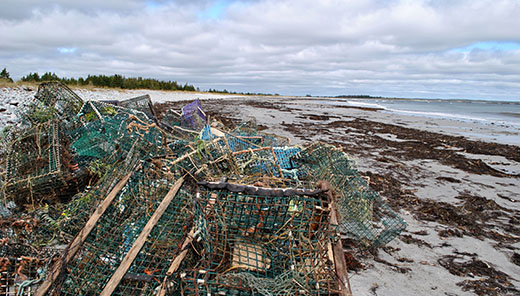
Activity: Design a postcard
Design your own postcard! Draw an image to help raise awareness of ghost gear and mail it to a friend or family member.
Instructions:
- Print this image on heavy paper like cardstock and cut out the postcard along the dotted line
- Draw your postcard image on the blank reverse side
- On the backside of the postcard (shown below), write your own message in the left column, and fill out your friend or family member’s address in the right column
- Don’t forget to use a stamp!
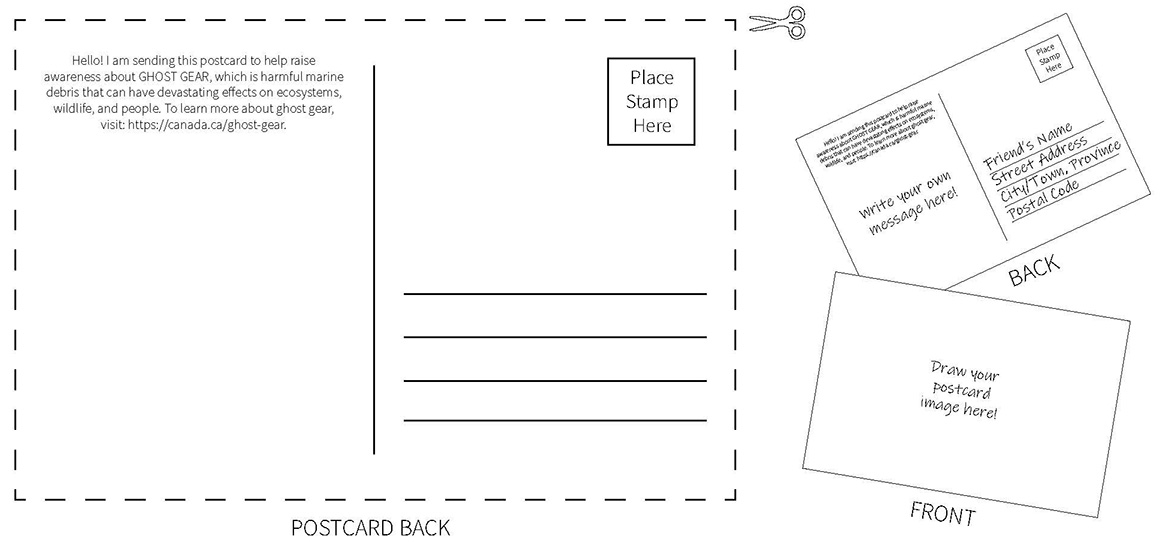
Text version
On the backside of the postcard is this pre-written message:
Hello! I am sending this postcard to help raise awareness about ghost gear, which is harmful marine debris that can have devastating effects on ecosystems, wildlife, and people. To learn more about ghost gear, visit: https://canada.ca/ghost-gear.
Activity: Write a ghost gear story
Storytelling has been a way of sharing knowledge for centuries. Write a creative story about ghost gear using the options below to help you share what you’ve learned with friends and family.
Instructions:
- Choose one option from each of the four columns:
- Who
- What
- Where
- When
- To help you choose, cut out all of the options and draw your selections from a hat.
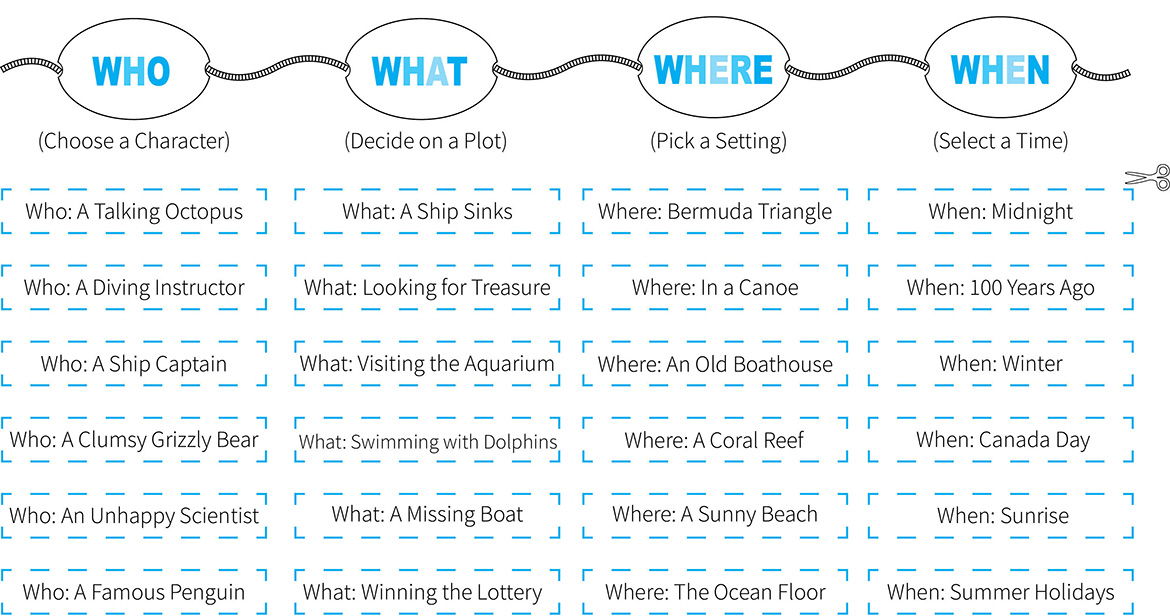
Text version
Who (Choose a character)
- A talking octopus
- A diving instructor
- A ship captain
- A clumsy grizzly bear
- An unhappy scientist
- A famous penguin
What (Decide on a plot)
- A ship sinks
- Looking for treasure
- Visiting the aquarium
- Swimming with dolphins
- A missing boat
- Winning the lottery
Where (Pick a setting)
- Bermuda Triangle
- In a canoe
- An old boathouse
- A coral reef
- A sunny beach
- The ocean floor
When (Select a time)
- Midnight
- 100 years ago
- Winter
- Canada Day
- Sunrise
- Summer holidays
Learn more
If you’re looking for more information on ghost gear, including the latest projects, research, and solutions, check out these experts:
- Fisheries and Oceans Canada (DFO)
- Global Ghost Gear Initiative (GGGI)
- National Oceanic and Atmospheric Administration (NOAA)
There are also many organizations and non-profit groups doing great work on ghost gear.
Search your community to see who’s working on what near you!
Statistics mentioned in this document:
- “It is estimated that ghost gear makes up as much as 70% of the weight of floating macroplastics in the five major ocean gyres.” Source: Eriksen, et al., 2014
- “Approximately 45% of marine mammals on the global threatened species list have been -impacted by lost or abandoned fishing gear.” Source: Werner et al., 2016
- “One study estimated 90% of species caught in ghost gear were of commercial value.” Source: Al-Masroori, Al-Oufi, McIlwain, and McLean, 2004
- “5-30% of fish stocks in some areas are caught in ghost gear every year.” Source: NOAA Marine Debris Program, 2015
- “From 2020-2022, Canada’s Ghost Gear Program removed 1441 metric tonnes of ghost gear from Canada’s Atlantic and Pacific coasts.” Source: Fisheries and Oceans Canada, 2022

- Date modified: